Day 3 of a three day, small group, socially-distanced Early Autumn Tour in Norfolk, our last day. The weather gods were still shining on us – it was a cloudy start, but with sunny intervals which increased into the afternoon, slightly chilly early on but warming up nicely.
The tide was not high enough for a full-on Wader Spectacular this morning, but it was almost there. Certainly enough to push all the waders right up against the saltmarsh, which should provide a pretty good spectacle anyway. It was an early start, to get up to the Wash in time for the tide. On the drive over, a Red Kite over the road eyeing up some roadkill was a new bird for the tour list.
We could see all the waders swirling around even before we got out to the seawall – something was stirring them up today. When we got out to the edge of the Wash, there was still quite a lot of exposed mud. A large slick of Oystercatchers was still smeared across the shore away to out right, up by the sailing club.
There were lots of smaller waders scattered around the small pools on the mud below us, lots of Ringed Plovers, Dunlin and a few Knot. One or two silvery-grey Sanderling were with them on the beach a little further along. Scanning through them, we found a couple of juvenile Curlew Sandpipers out on the mud too. We got them in the scope – scaly backed, longer billed and clean white below compared to the nearby Dunlin, with a variable pale peachy wash across the breast.
The tide was coming in fast. The Oystercatchers were peeling off from the mud and flying past us, catching the low morning sun peeking through the clouds behind us. They landed again out on the mud higher up. The water was pushing the small waders up onto the beach in front of us too. Two Curlew Sandpipers dropped in and went straight to sleep in amongst the stones and samphire, with a third following them in shortly after.
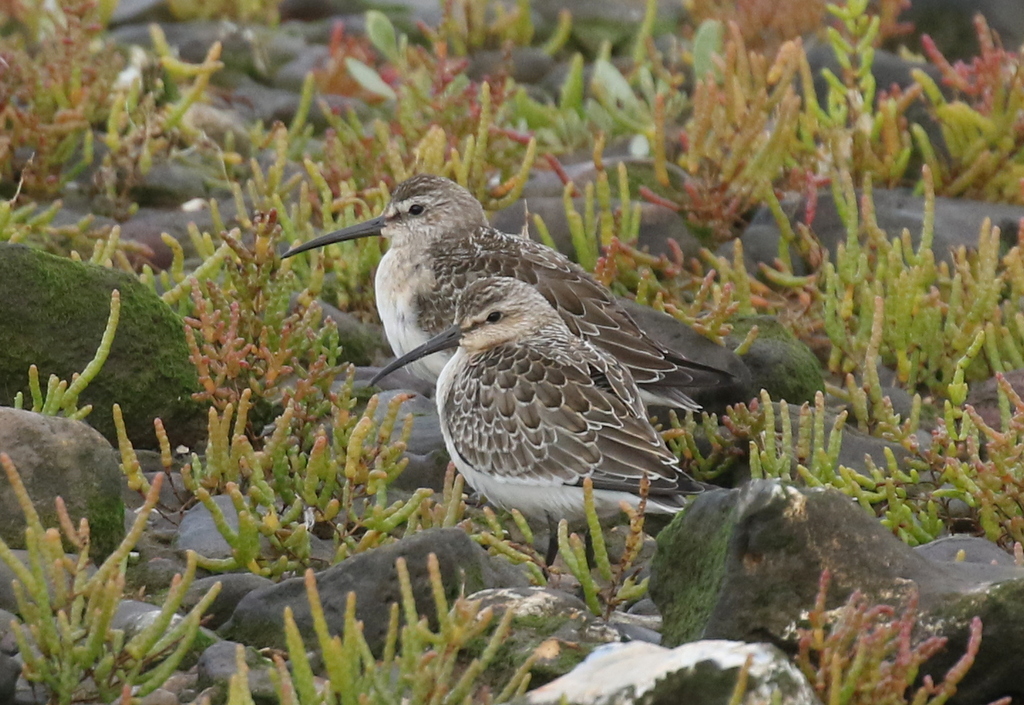
Eventually the rising tide pushed everything off the beach in front of us, so we made our way further down, towards Rotary Hide. More birds were flying in all the time from around the Wash. While we were watching all the mass of birds gathering on the mud, we noticed something coming in fast and low over the water, a Peregrine.
As the Peregrine got towards the mud, chaos erupted. All the Knot took to the sky at once, thousands of birds in a vast flock. They swirled round, twisting and turning, making different shapes like a fast-changing cloud. Always amazing to watch.

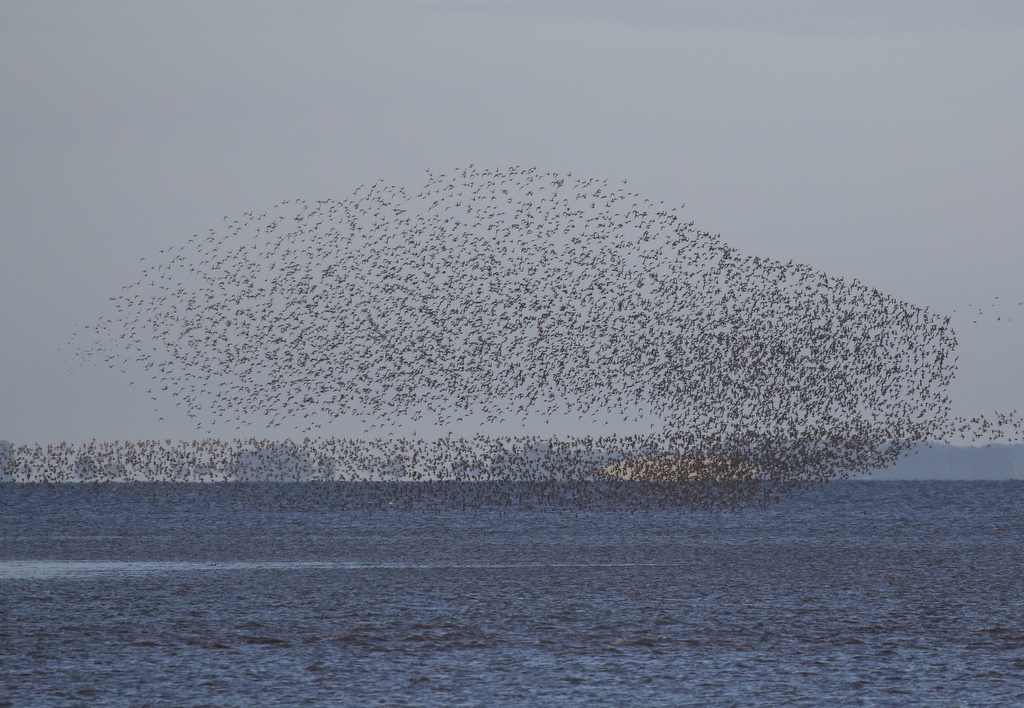
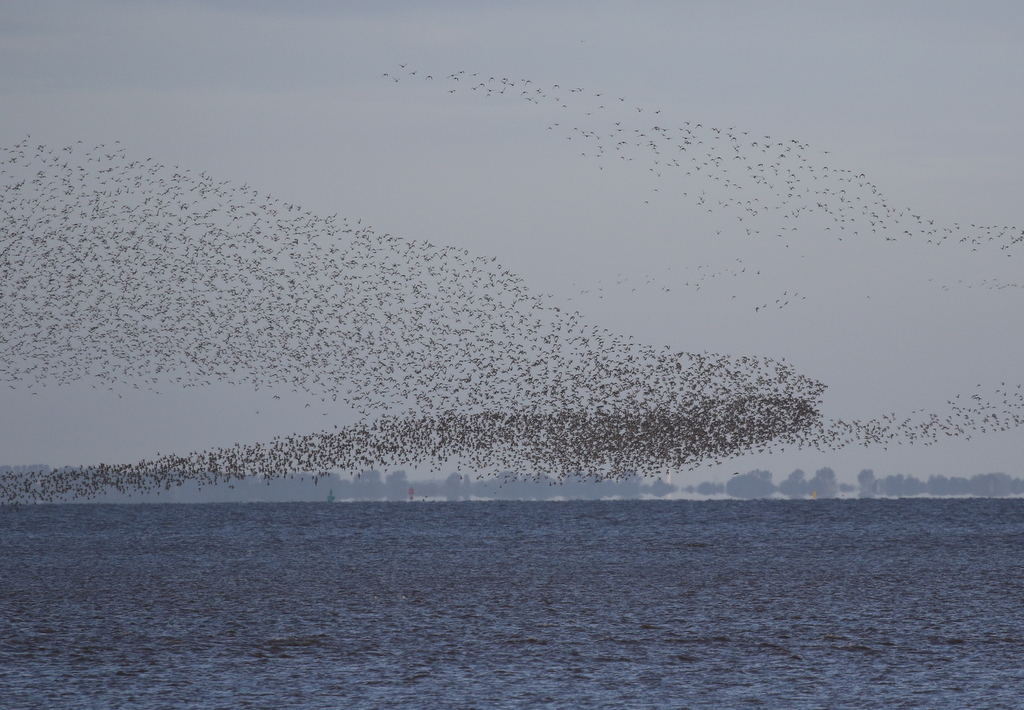


The Peregrine seemed to have moved on, so after a while the Knot settled back down. The Oystercatchers had barely reacted and were now increasingly concentrated on the edge of the rapidly rising tide. We continued on further down, to the grass opposite the last remaining area of mud.
A sizeable flock of Knot was in front of the Oystercatchers, on the far side of the deep channel in front of us. Most were in their grey non-breeding plumage now, but there were still several sporting the remnants of their orange summer attire. There were quite a few Bar-tailed Godwits in with them too, and some of those were still in breeding plumage as well, the rusty orange colour of their underparts continuing down under their tails. A lone Black-tailed Godwit was standing in the water beyond, looking slightly lost.
We watched as the Knot and godwits were pushed in by the tide, walking up ahead of the rising water, increasingly squashing them into the mass of Oystercatchers behind.

The Oystercatchers were on the move too – the whole flock seemed to be flowing slowly across the mud, away from the approaching water, as those on the edge walked further up, passing through other which were hoping the water wouldn’t reach them. The march of the Oystercatchers – one of the many favourite moments of the whole spectacle.
We thought there were quite a few waders on the mud in front of us, but there were thousands more further round the shore just out of view. All the waders were still jumpy. We could see a few raptors out over the saltmarsh beyond – Common Buzzards and one or two Marsh Harriers – but they were too far back to be causing any trouble.
Presumably the Peregrine was still in the area, because suddenly a vast flock of Knot erupted in the distance, from the next bay, beyond the line of saltmarsh at the back of the mud in front of us. It looked like a huge cloud and again we watched as it twisted and turned before settling back down out of view.

The waders closer to us kept flying up too, partly out of nervousness, partly as they shifted higher up ahead of the tide. Increasingly, the whole flock was packed into the last corner of remaining mud and then the tide started to slow and go slack. We could see more Sanderlings in with the other waders now, and a good number of Grey Plover, most still sporting their summer black faces and bellies, to a greater or lesser extent.
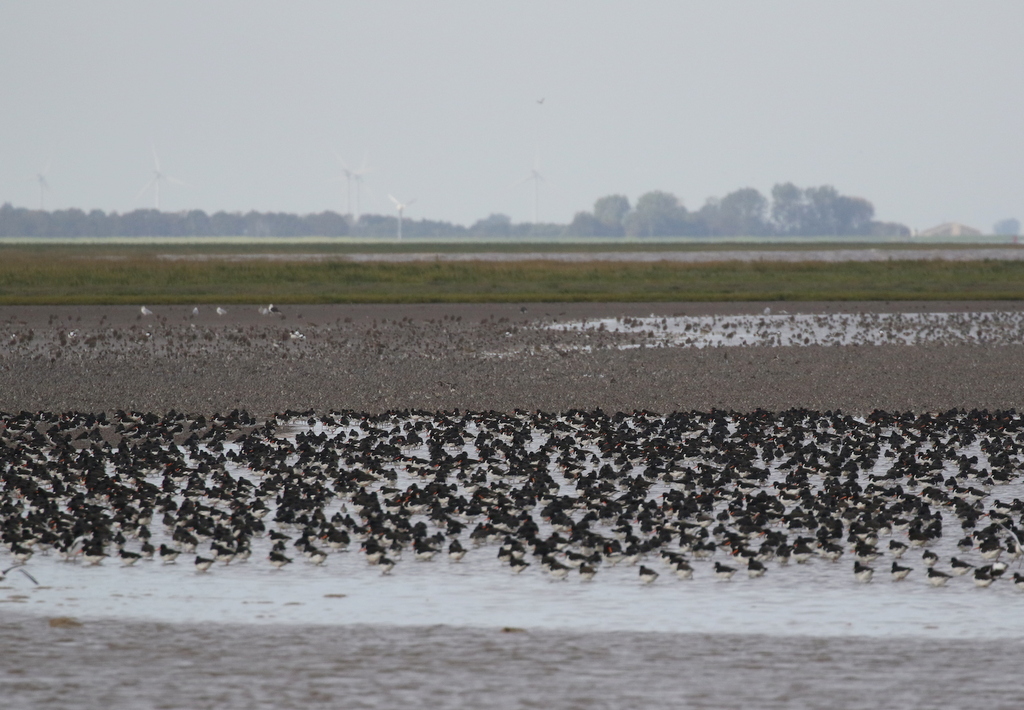
We waited a short while to see if anything would spook the waders, but they increasingly settled down to roost. While most of the waders would stay out on the mud over high tide today, we had watched a few flying in to the pit, including the Curlew Sandpipers earlier. We decided to have a look in Shore Hide and see what was on there.
When we got into the hide, we immediately noticed a large white bird in with the Greylags just behind the island right in front. Despite it being asleep and not flashing its bill we could see it wasn’t one of the escaped domesticated white geese this time, but a lone Spoonbill. In the absence of any more of its kind it had obviously decided the geese were the next best thing. It did wake up briefly a couple of times, particularly when a Little Egret flew in calling and landed next to it briefly.
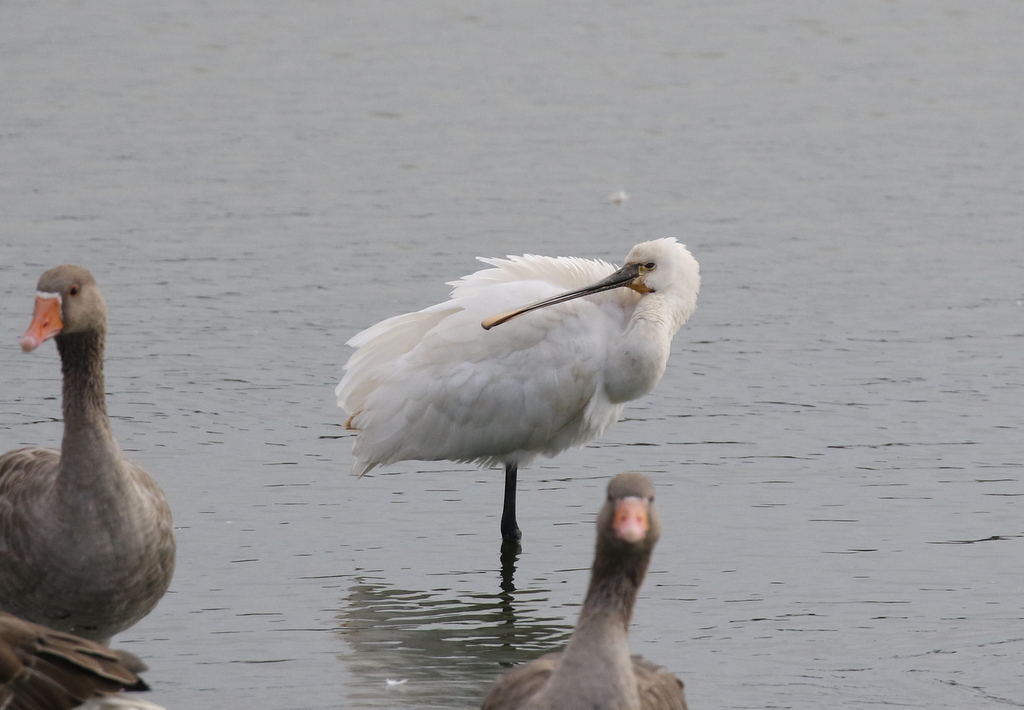
There were not so many waders on here today, with most of the birds staying out on the Wash. There were a few Oystercatchers which had come in, roosting on the shingle bank to the south of the hide. One of the low islands, furthest from the hide, was fairly full with all of the Black-tailed Godwits which seem to come in regardless and lots of Common Redshanks.
Out in the middle, more Greylags and Cormorants were roosting on the partly submerged lumps of concrete. Half hidden in amongst them we could see six or seven Spotted Redshanks, their usual favoured roosting spot. They were asleep, hiding their long, needle-fine bills, but they were noticeably paler than the Common Redshanks, more silvery grey above and whiter below.
Scanning one of the other low islands, we found another lone Spotted Redshank in with yet more Greylags. It had a noticeably limp, which was perhaps why it wasn’t roosting with the others. Initially it was awake, so this time we could see its distinctive bill, and the well-marked white supercilium extending over the bill and back to the eye, before it went to sleep. Through the scopes, we could also see it still had one or two black summer feathers which had not yet been moulted. A Turnstone and a single Dunlin appeared from between the geese and joined it.
There were several juvenile Common Terns still on the pit. At one point, an adult flew in and landed on the tern island with a large fish in its bill. It’s youngster had obviously gone elsewhere, as the adult perched on the edge calling for it for a while, before it flew off again still carrying the fish. A single eclipse drake Pintail out on the water was the only duck of note. A Common Sandpiper flew round calling, but we couldn’t see it.
It was well past high tide now, so we went back out to the edge of the Wash. The water was already starting to recede and the waders had started to spread out a little. We stood on the shore to watch. There was a trickle of hirundines, Swallows and Martins, making their way south and a single Common Swift, reminding us that it won’t be long now before they have all left us again for the winter.
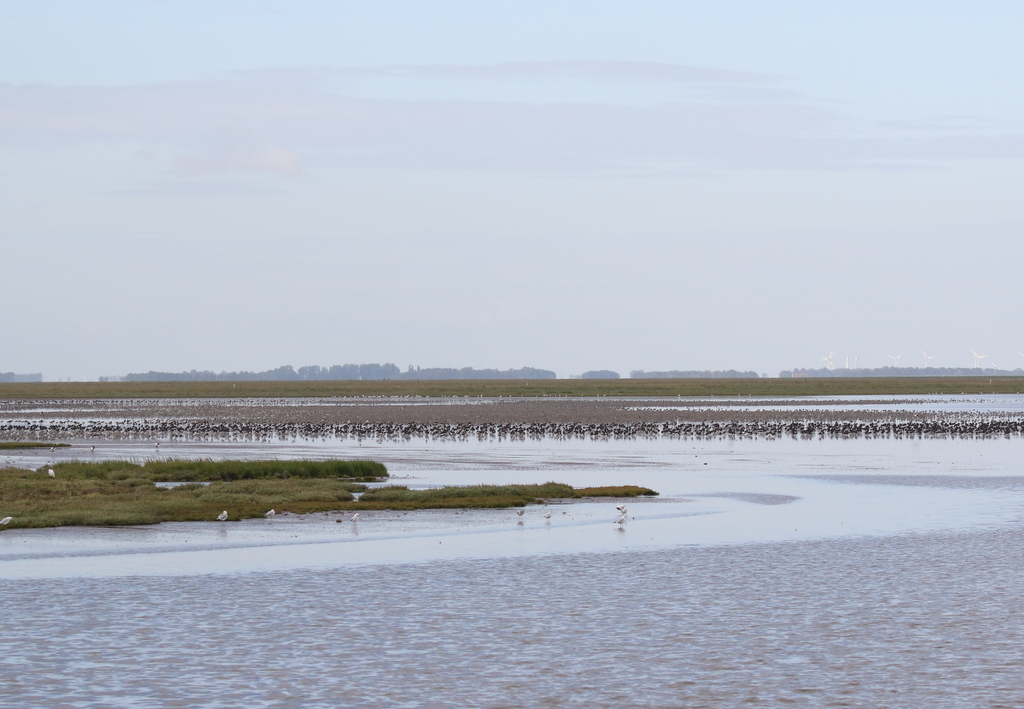
Rather than walking down the mud to follow the tide, the flocks kept flying up and landing again nearer the edge of the water. It was quite impressive, but in the absence of the local Peregrine now they quickly settled back down again.
A lot of the Oystercatchers landed on the mud in front of where we were standing. Some groups of Knot and Bar-tailed Godwit flew in and joined them, giving us a good close look at them through the scopes. One of the godwits was carrying a white leg flag and through the scope we could see it had the letters ‘CX’ on it. There is a very active ringing group on the Wash, and it was one of theirs – but it will be interesting to learn if it has been anywhere since it was ringed.
When the large group of birds in front of us took off and whirled round, it was particularly impressive, looking into a huge mass of Oystercatchers.
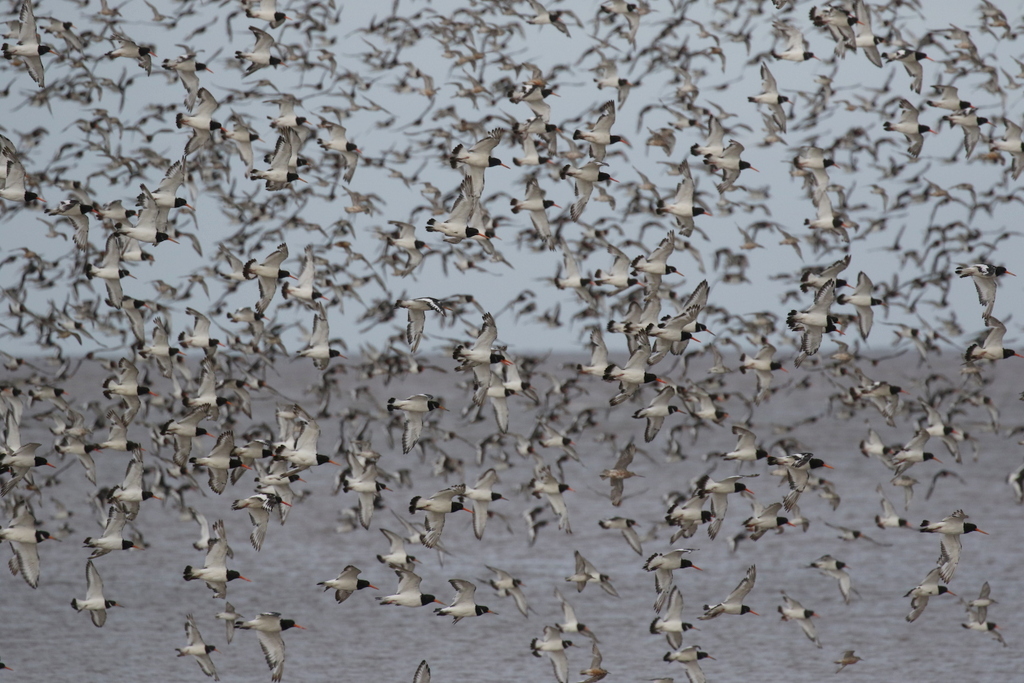
Even though it wasn’t one of the biggest tides today, we had still had a great morning and everyone agreed it was well worth the early start. We were heading for Titchwell next though and speaking to a couple of the volunteers at Snettisham we were told that the car park had filled up early yesterday, with half of it still closed off. We decided to head round now to try to make sure we didn’t get caught out.
When we got to Titchwell, we were glad we had gone early. There weren’t many spaces left and thankfully one of the volunteers was on hand in the car park to help us find somewhere to park. Thanks, Les!
We still had time before lunch, so we decided to head round along Fen Trail first, to Patsy’s Reedbed. A Little Grebe was diving continually in the water just below the screen. A couple of Tufted Ducks and Coot a little further back were new birds for the trip list. But otherwise there wasn’t much on here today.
The Autumn Trail is open at the moment, so we continued on round in that direction. There were lots of Bloody-nosed Beetles on the path (several of which were move to avoid them getting trodden on) and a couple of Common Darters basking on the hard surface. The hedges and Willow Wood were rather quiet, although it was the middle of the day now.
As we got to the end of Autumn Trail, we stopped to scan the back corner of the Freshmarsh. There were several Ruff, and a little group of Dunlin tucked into the far corner, along with a Grey Heron. An adult Spotted Redshank appeared, silver grey and white, before taking off and calling as it flew over the bank towards Brancaster.
Further out, in the middle of the Freshmarsh, we could see a bigger flock of waders – hundreds of godwits, both Black-tailed and Bar-tailed, and smaller numbers of Knot – despite it being well after high tide now. Smaller groups of Dunlin were scattered around the edges of the islands and in with them we found a party of five juvenile Curlew Sandpipers, as well as singles of Ringed Plover and Little Ringed Plover. A single Common Snipe was half hidden in the behind the fence on the edge of Avocet Island.
When most of the waders took to the air, we looked across to see a Peregrine stooping at them. It was a young bird, inexperienced, and didn’t seem to know quite what to do. It circled up and then stooped again, but each time seemed to fail to find a possible target. When it circled up higher, we noticed a second falcon, much higher and more distant in the sky beyond and through the scopes we could see it was a Hobby.
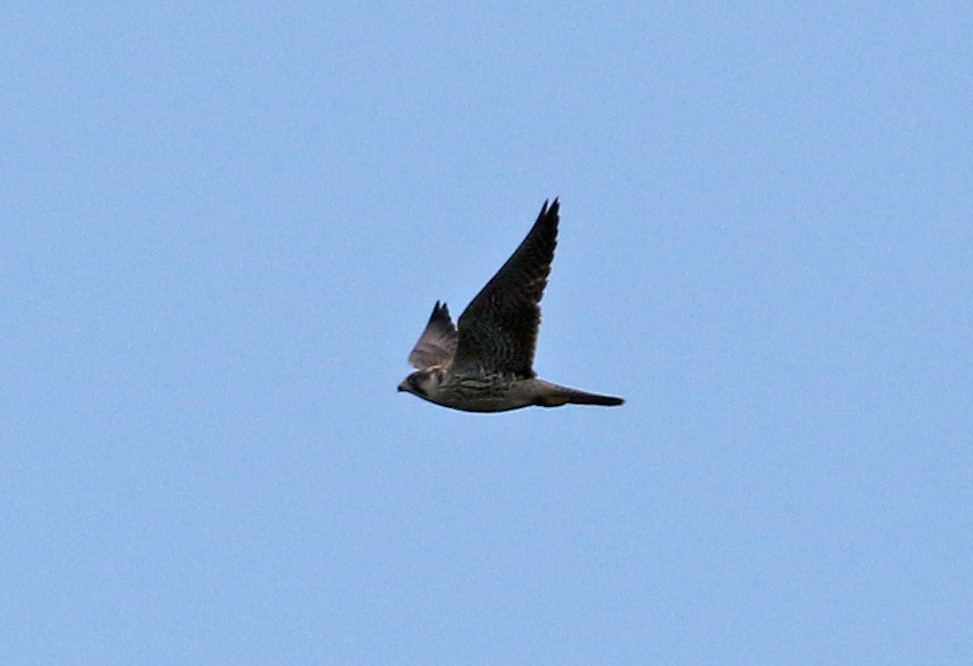
The Peregrine had another swoop at the waders on the Freshmarsh, before drifting off west. As we followed it, it was joined by a second Peregrine, another juvenile and we watched the two of them head off towards Thornham. We turned our attention back to the Freshmarsh, but it wasn’t long before one of the Peregrines was back again and stirring things up again.
We could hear Bearded Tits calling from the reeds below the watchpoint, but they didn’t show themselves. We decided to head back for lunch now, and looked up to see another Common Swift flew off west low over the reeds.
We had lunch back in the picnic area in the sunshine, with one or two Speckled Wood butterflies and Common Darters basking on the benches. Checking the news, we could see that the first Pink-footed Geese of the winter had returned this morning – small flocks had been seen over Titchwell earlier and further east to Holkham. It would prove to be a feature of the afternoon, with the first flock we saw coming over the car park as we packed away our lunch things.
Next, we headed back out along the main West Bank path. A stop at the Reedbed Pool added a couple of Common Pochard to the trip list. As we walked on towards Island Hide, we could hear more Bearded Tits calling but despite it not being too windy the best we had were a couple of brief views as they flicked across between patches of reeds. A couple of Sedge Warblers were more obliging – one flyatching from the top of the reeds, the other way working its way round the edge of one of the pools.
As it was sunny, and the recent SW winds had dried out the mud in front of Island Hide, we decided to scan the Freshmarsh from the bank further along. The big flock of godwits was still out in the middle and a quick count of the Bar-tailed Godwits suggested at least 450, a very good number for here. There were still a few Avocets out here too, in the deeper water further back. Two Golden Plover flew over high calling and dropped down to join the throng.
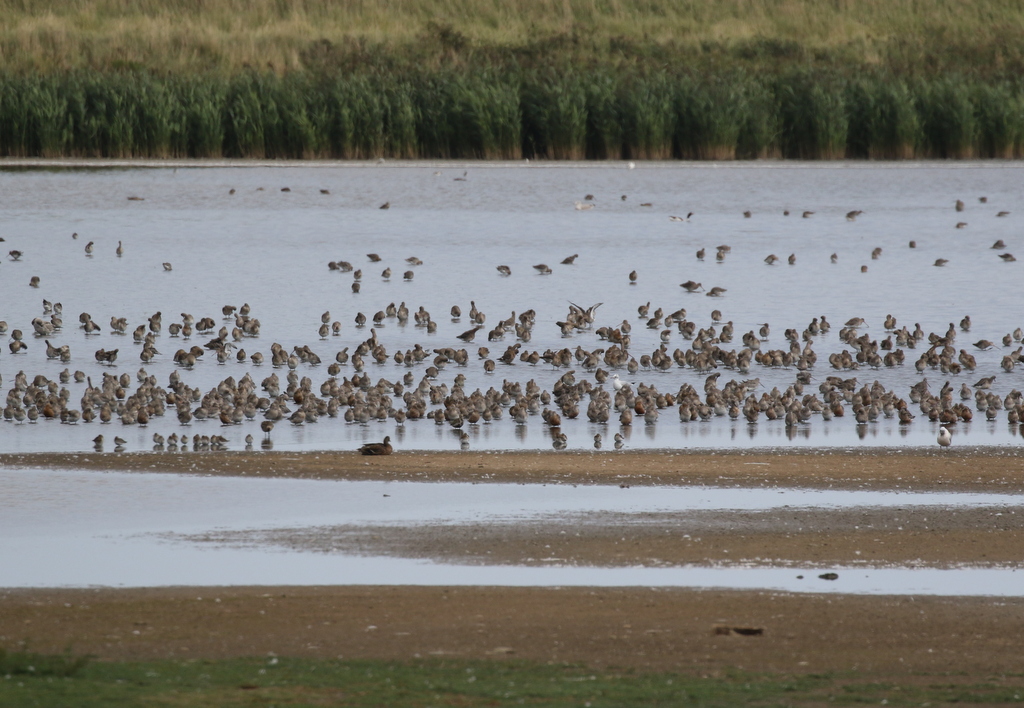
Numbers of smaller waders appeared to have declined since earlier – perhaps not a surprise after the repeated attentions of the Peregrine. There was still a small group of Dunlin on the edge of the island in front of the godwits, but only two Curlew Sandpipers with them now. There had been a Little Stint here yesterday but there was no sign of it now, so we decided to continue out towards the beach.
Volunteer Marsh was quiet, apart from a couple of Curlews and some Redshanks on the banks of the channel at the far side, and there were more of the same, plus a Little Egret on the Tidal Pool. We continued on to the beach. There were quite a lot of people out here again today, and quite a few prams! With older children mostly heading back to school, the staycationer mix has shifted to families with younger offspring.
Despite the people, there were a few waders down on the mussel beds, Oystercatchers, a few Knot and Turnstones. As we stood and scanned, the godwits finally seemed to decide to come out from the Freshmarsh to feed and we watched groups of both species flying out across the beach. One of the Curlew Sandpipers flew out too, flashing its distinctive white rump.
Looking out to sea, we picked up a very distant group of Common Scoter flying across and when they landed on the sea in front of the wind turnbines we could see a line of several hundred already out there. Already returned from further north, they will now spend the winter off here or round to the mouth of the Wash. Otherwise, there were two or three Great Crested Grebes on the water closer in and one or two Gannets flying round right out on the horizon.
When we heard the distinctive yelping calls of Pink-footed Geese in the distance, we looked out to sea to see several flying in towards us, fresh arrivals here for the winter, fresh in from their breeding grounds in Iceland or possibly having stopped over night in Scotland on their way here. They were in several small groups rather than one skein, but we counted 45 in total.
It was time to start heading back – after an early start, we would have a slightly earlier finish today. We stopped again to scan the Freshmarsh, and the five Curlew Sandpipers had reappeared with more Dunlin. Two Little Ringed Plovers were now down on the mud on the edge of the reeds near Parrinder Hide. Further back, we could see a Spotted Redshank but not the pale silvery grey adult we had seen earlier – this time a dusky grey fresh juvenile.
Scanning the reeds over the other side, we found three Bearded Tits working their way along the edge just above the mud. We got them in the scopes for a closer look. A small party of Swallows and House Martins came across the Freshmarsh, a couple of the Swallows pausing just long enough to take a drink before continuing on their way west.
More yelping calls alerted us to another small skein of Pink-footed Geese coming in behind us over the saltmarsh. We watched as they flew high overhead and continued on east, presumably heading for their traditional roost site at Holkham.
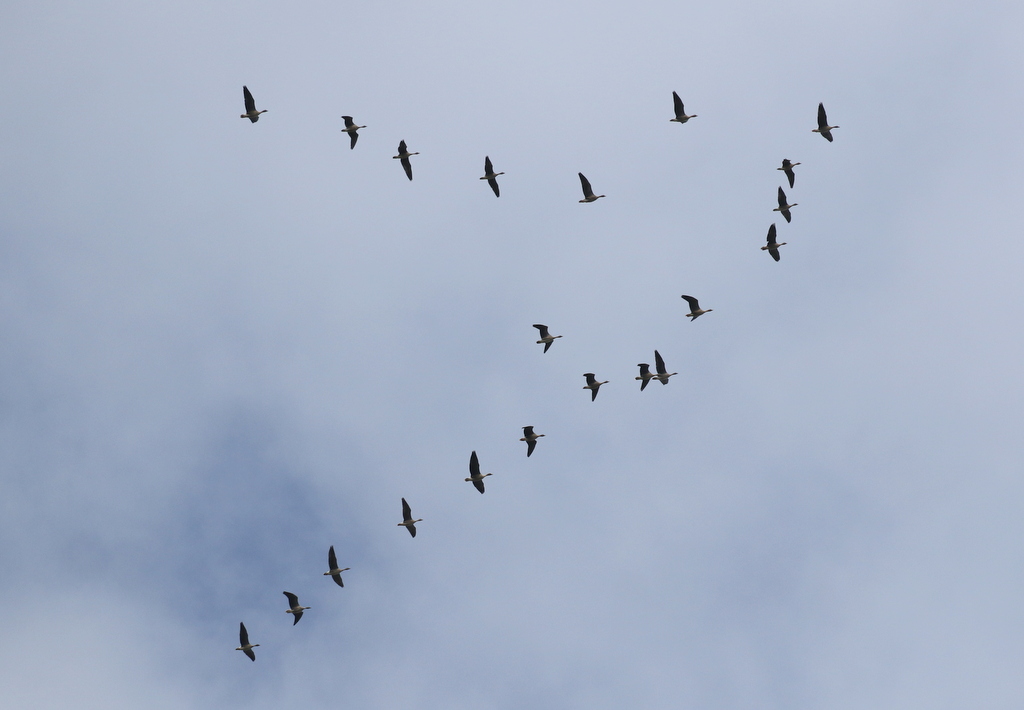
It was a nice way to end the tour – watching autumn migration in action, with birds arriving here, the changing of the seasons.
















